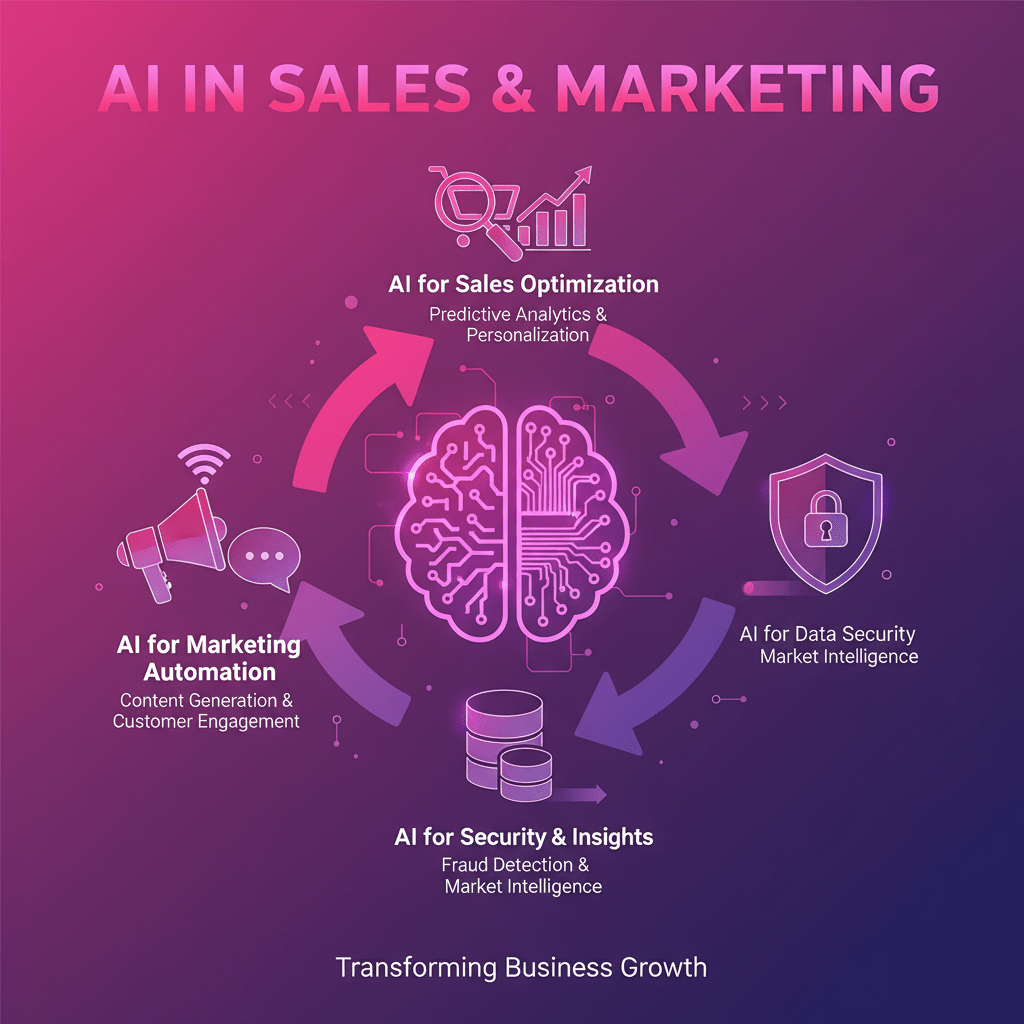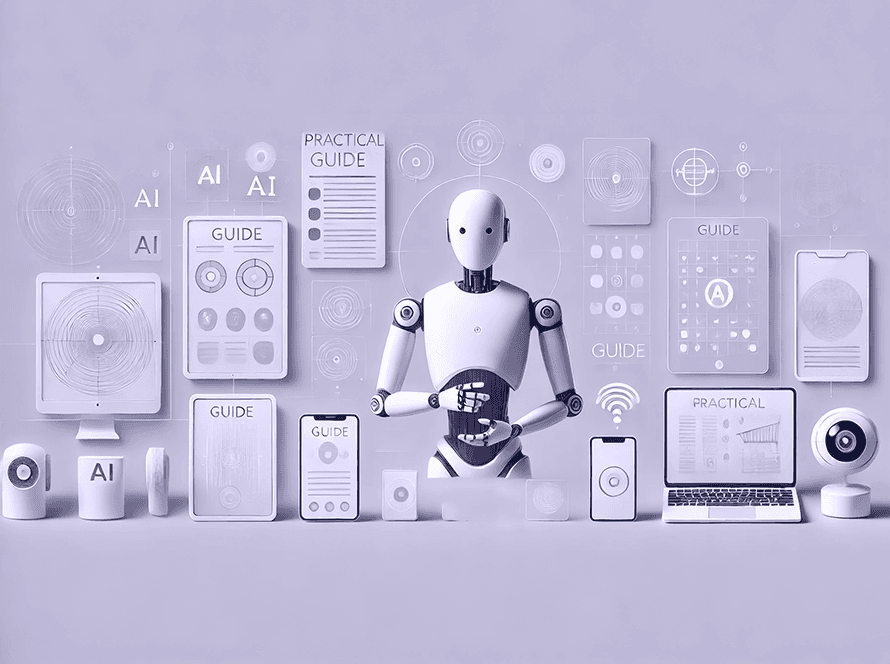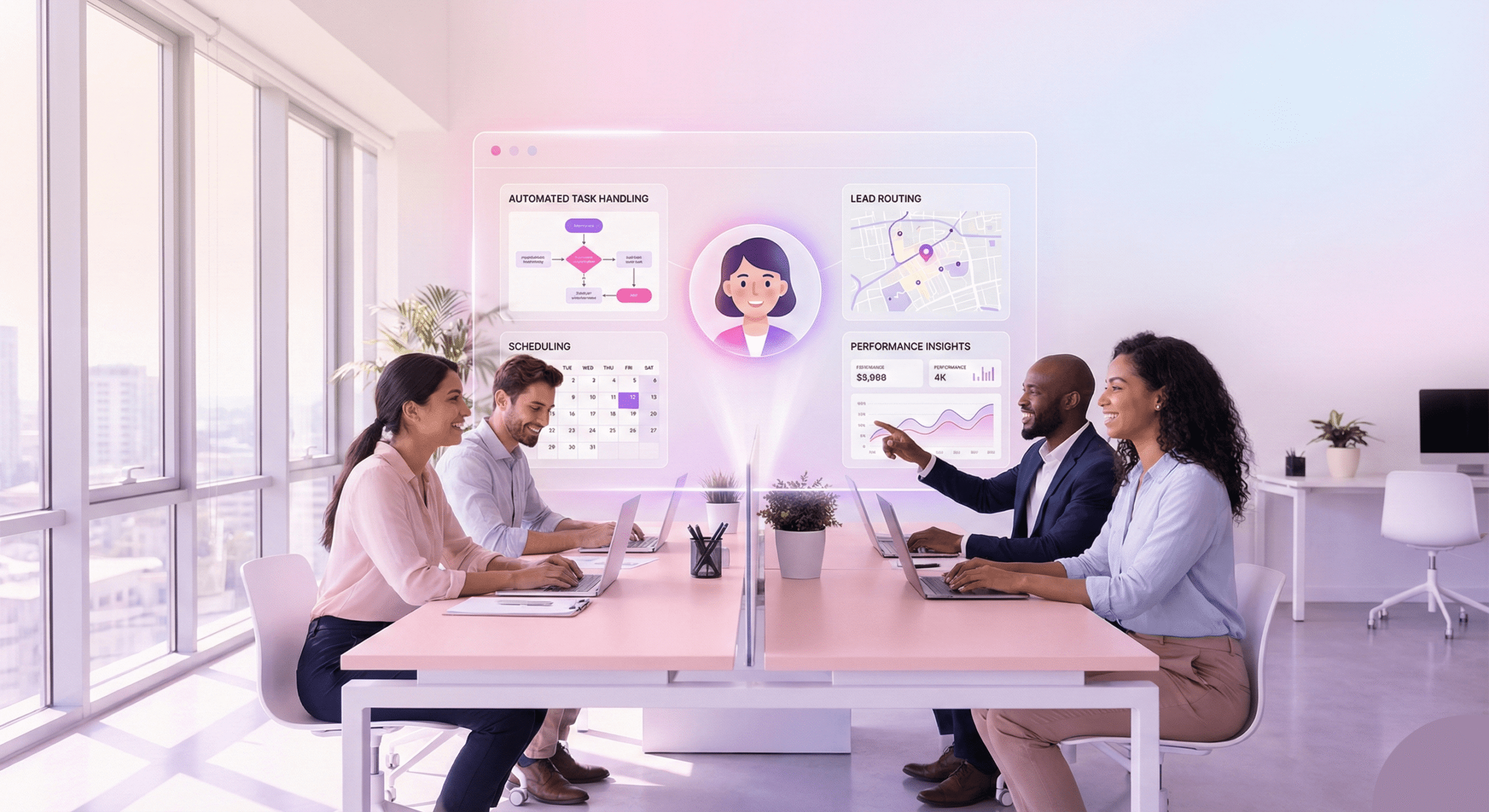“Connect sales and marketing for 24/7 engagement, predictive lead scoring, and zero friction to build a unified revenue machine with AI in sales and marketing.”
The year is 2025. Your company’s best salesperson works 24 hours a day, seven days a week. It never sleeps, never takes a vacation, and never forgets a single detail about any customer. It handles ten thousand conversations at once, each one perfectly tailored to the individual. It speaks every language fluently. And it instantly qualifies every single lead that comes to your website, booking qualified meetings directly onto your human team’s calendar.
This isn’t science fiction. This is the reality of AI in sales and marketing.
For decades, we’ve operated with a broken model. Marketing teams spend fortunes generating “leads,” which are often little more than a name and an email address. They throw these leads over a digital wall to the sales team. Sales, already overwhelmed, struggles to follow up. Studies show that the chance of qualifying a lead drops dramatically after just five minutes. By the time a rep calls that “hot lead” 24 hours later, the prospect has moved on, forgotten why they were interested, or already received a call from a competitor.
This gap between marketing and sales is not a small crack; it’s a canyon where your revenue goes to die.
Artificial intelligence is the bridge. It’s not just another tool or a buzzword. It is a fundamental shift in how we attract, engage, qualify, and close customers. It’s the engine that finally connects the marketing department’s efforts with the sales department’s results, creating a single, measurable, and highly efficient revenue machine.
This guide is your complete map to this new landscape. We will explore the distinct revolutions happening in marketing and sales. Most importantly, we will show you how AI builds the critical link that unifies them, solving the age-old problem of sales and marketing alignment once and for all.

Part 1: The New Marketing Powerhouse: How AI Changes the Game
Marketing used to be an art of educated guesses. We built personas based on assumptions. We ran broad campaigns hoping to catch the right people. We examined last-click attribution, hoping it would reveal the true story.
AI replaces those guesses with mathematical certainty. It sifts through data sets larger than any human team could ever comprehend, finding patterns that reveal exactly who your customer is, what they want, and when they want it.
Deeper Than a Name: True AI Content Personalization
For years, “personalization” meant a mail merge that inserted [First_Name] into an email subject line. This is no longer enough. Customers expect you to know them.
AI content personalization makes this a reality at scale.
- Dynamic Website Content: AI can alter your website in real-time for every single visitor. Imagine a visitor from the healthcare industry lands on your homepage. Instead of your generic “We help businesses grow” tagline, they see “The Top-Rated Software for HIPAA-Compliant Data Management.” The case studies they see are from hospitals, not retail stores. The call-to-action changes. This isn’t just a different landing page; it’s a 1-to-1 conversation.
- Intelligent Email Nurturing: Say goodbye to the static “drip campaign” where every user receives the same five emails in the same order. Marketing automation AI watches how a user interacts. Did they click a link about pricing? The AI then sends a value-comparison guide. Did they ignore two emails? The AI modifies the subject line strategy or conducts an A/B test of a new offer. It learns and adapts in real-time.
- Predictive Recommendations: This is the “Netflix” or “Amazon” effect. AI analyzes a user’s behavior—pages viewed, content downloaded, time on site—and compares it to millions of other user profiles. It can then accurately predict what piece of content, product, or service the user will want to see next. This moves the user through the funnel faster because you are answering their next question before they even ask it.
More innovative Advertising: Ending Wasted Spend
Pay-per-click advertising can feel like burning cash. You set an audience, cross your fingers, and hope the right people click. AI eliminates the guesswork in media buying.
AI algorithms analyze your best existing customers and build complex “lookalike” audiences. They can find thousands of new prospects who share the same obscure digital breadcrumbs as your top accounts. Furthermore, AI-powered bidding tools can analyze performance in real-time, shifting your budget away from underperforming ads and toward high-converting ones before a human analyst even runs a report. The result is a higher Return on Ad Spend (ROAS) because your ads are only shown to people who are genuinely likely to be interested.
Mapping the Chaos: Customer Journey Analytics
The old marketing funnel—Awareness, Interest, Decision, Action—is dead. It was never that simple.
Today, the customer journey is a chaotic web. A prospect might see your ad on LinkedIn, visit your site, leave, read three third-party reviews, ask a question on social media, revisit your site on their phone, and then download a whitepaper.
Human-led tracking can’t keep up. But AI-powered customer journey analytics can. These tools connect data from all your touchpoints (website, CRM, social media, ad platforms) to build a visual map of how your customers actually behave. This is revolutionary. You can finally see where leads get “stuck.” You can identify the top five pieces of content that lead to a conversion. You can determine which channels are generating real value and which are merely noise.
Seeing the Future: Predictive Analytics in Marketing
This is where AI gets really powerful. Instead of just looking at what happened, AI can tell you what is about to happen.
Predictive analytics in marketing utilizes historical data to forecast future outcomes. Its most important application is predictive lead scoring.
Your old lead scoring was probably rule-based. “Downloaded a whitepaper? +10 points. Visited the pricing page? +20 points.” This is a good start, but it’s still just a guess.
AI looks at every customer you’ve ever won and lost. It analyzes hundreds of data points:
- Firmographics: Company size, industry, revenue.
- Technographics: What technology do they already use?
- Behavior: Which 10 pages did they visit? How long did they watch your webinar?
- Intent Data: Are they currently searching for your competitors online?
The AI builds a model of your perfect customer. Then, when a new lead comes in, it’s instantly scored from 0 to 100 based on its actual likelihood of closing. This changes everything. Marketing stops sending a high volume of leads to sales. Instead, they send a curated list of leads that are statistically proven to be a good fit. This is the first, crucial step toward proper alignment.
Part 2: The AI-Powered Sales Machine: Prospecting, Engaging, and Closing
While marketing becomes a data-driven science, sales is being freed from its worst burdens. Sales reps are, by nature, “people” people. They are communicators, negotiators, and relationship builders. Yet, most reps spend over 60% of their time not selling.
They are buried in administrative tasks, data entry, and prospecting for leads that yield no results. AI gives them their time back and turns their “art” of selling into a science.
Finding the Needle in the Haystack: Intelligent Prospecting
Prospecting is often the most hated part of a sales rep’s job. It’s a manual, soul-crushing grind of searching LinkedIn, checking company lists, and making cold calls.
AI tools now act as an autonomous prospecting team. Reps input their Ideal Customer Profile (ICP)—for example, “VP of IT at SaaS companies in North America with 500-1000 employees who just received Series B funding.” The AI scans the entire internet, encompassing news articles, social media, job boards, and press releases, to find matches.
But it goes further. It looks for intent signals.
- Did that company just hire a new “Head of Revenue Operations”? That’s a buy signal.
- Did their competitor just sign with your rival? That’s a buy signal (they need to keep up).
- Have they posted a job looking for a skill that your software automates? That’s a massive buy signal.
The AI delivers a daily list of “who to call now and why.” This means every outreach is warm, relevant, and timely.
The Self-Updating Brain: The AI-Powered CRM
The Customer Relationship Management (CRM) system is the single source of truth for any revenue team. But it has a fatal flaw: it relies on humans to manually enter data. Reps hate it, so they either don’t do it or do it poorly.
An AI-powered CRM solves this.
- Task Automation: AI transcribes sales calls automatically. It logs every email and meeting. It updates the deal stage based on the sentiment of the conversation.
- Data Augmentation: AI automatically enriches contact records by finding the prospect’s LinkedIn profile, correct title, and company details, eliminating the need for manual research.
- Proactive Coaching: This is the most exciting part. The AI listens to all sales calls. It identifies which talking points lead to a second meeting. It can alert a manager in real-time: “This deal is at risk. The prospect mentioned ‘budget’ 5 times.” It can even whisper suggestions to the rep during a live call: “This prospect matches the persona that loves Case Study B. You should mention it now.”
It transforms the CRM from a stagnant database into a dynamic sales coach that helps reps close more deals.
Predicting the Future: Accurate Forecasting and CLV
Sales managers dislike “happy ears” (reps who believe the deal is closing) and “sandbagging” (reps who conceal their best deals to ensure they meet quota). Both habits make forecasting a nightmare.
AI introduces objectivity. It analyzes deal progression, the frequency of communication, the sentiment of the prospect’s emails, and the rep’s historical close rate. It then provides a clear, unbiased percentage chance that the deal will close. This allows leaders to make accurate revenue projections.
Beyond the initial deal, AI models can accurately predict a customer’s lifetime value. By analyzing the customer’s profile, a.i. Can expect their long-term value. This is critical. It helps sales and customer success teams identify which accounts to focus on for upsells and cross-sells, thereby maximizing revenue from existing customers.
Part 3: The Critical Bridge: How AI Unites Sales and Marketing
We have established two powerful, AI-driven engines. A marketing engine that creates high-quality, predictively-scored leads. A sales engine that is hyper-efficient at closing them.
Now, we must address the 110-trillion-dollar question: What happens in the five minutes between those two engines?
This is the gap. This is the “MQL graveyard.” This is where sales and marketing alignment—often referred to as Smarketing—has failed for over 30 years.
The “Smarketing” Problem: Why Alignment Fails
The traditional handoff is a disaster.
- Marketing: “We generated 100 MQLs from the webinar! We hit our goal!”
- Sales: “These leads are junk! Fifty were students, 30 never answered the phone, and the 20 I did talk to aren’t the decision-makers and have no budget!”
- Marketing: “Sales is lazy! They didn’t follow up fast enough. The leads were hot!”
Both teams are right. The leads were hot, but only for a fleeting moment. The sales team is working hard, but they are wasting time on leads that aren’t truly qualified.
This isn’t just a people problem. It’s a process problem. It’s a speed problem. The moment a prospect shows high intent (like filling out a “Contact Us” form or downloading a late-stage buyer’s guide), the clock starts ticking. A human rep is in a meeting. They are at lunch. They are asleep.
By the time the rep follows up, the prospect’s intent has vanished. They’ve already found an available competitor.
The Foundation for Alignment: Revenue Operations (RevOps)
To address this, companies are adopting a new philosophy known as Revenue Operations (RevOps).
RevOps is a strategic framework. It breaks down the silos between marketing, sales, and customer service. It unifies them into a single “Revenue Team” with shared data, shared goals, and shared accountability. The goal is no longer “MKS MQLs” or “Sales’ Close Rate.” The only goal is “Total Revenue.”
If RevOps is the philosophy, AI is the technology that makes it possible. AI provides the shared, objective data that all three teams can trust. The AI-powered CRM becomes the central brain for the entire revenue operation.
The Speed-to-Lead Crisis and the AI Solution
This brings us back to the most critical failure point: the MQL-to-SQL handoff.
You need a way to engage, qualify, and book leads the second they show intent. But your human sales team cannot work 24/7/365.
Your AI can.
This is the most profound application of AI in sales and marketing. We are not talking about a simple, rules-based chatbot that pops up with “How can I help you?” and offers three pre-programmed buttons. We are discussing an autonomous AI agent designed solely for one purpose: to convert marketing intent into a sales-qualified meeting.
The Seamless Handoff: AI for Lead Nurturing and Instant Engagement
Let’s paint the new picture. It’s 2:15 AM on a Sunday. A Head of IT in London just finished reading your blog and downloaded your “Ultimate Buyer’s Guide.”
The Old Way (The Leaky Bucket):
- 2:15 AM: Lead gets an auto-reply: “Thanks for your interest. Our team will contact you shortly.”
- Monday, 9:00 AM: The lead appears in a sales rep’s queue in New York.
- Monday, 11:30 AM: The rep, after two other meetings, finally calls. The prospect is busy and sends it to voicemail. The rep leaves a generic message.
- Result: The lead is cold. The $150 in ad spend used to get that lead is wasted.
The New Way (The AI Bridge):
- 2:15 AM: The lead downloads the guide.
- 2:15:01 AM: An autonomous AI agent, like SalesCloser.ai, instantly engages the lead via chat or email. It doesn’t use a generic script. It says, “I see you’re reading our buyer’s guide on data management. Are you currently facing challenges with system integration or data security?”
- 2:16 AM: The prospect, impressed, replies: “Both, actually. We are worried about security.”
- 2:17 AM: The AI agent begins a natural, conversational qualification process. This is true AI for lead nurturing. It’s not a “drip”; it’s a conversation. It inquires about their current provider, team size, timeline, and budget—the key qualification questions (BANT).
- 2:20 AM: The AI has determined this is a perfect-fit lead. It says, “Based on your needs, our ‘Enterprise’ package would be a perfect fit. Our Head of Solutions, Sarah, has availability this Tuesday. Does 10:00 AM your time work for a brief demo?”
- 2:21 AM: The prospect agrees. The AI agent, integrated with the sales team’s calendars, automatically books the meeting.
- Result: When the sales rep, Sarah, wakes up on Monday, she doesn’t have a “cold MQL” to chase. She has a fully qualified, high-intent appointment already on her calendar, complete with a full transcript of the AI’s qualification conversation.
This is the end of the MQL-to-SQL gap.
This is the single most powerful function of AI in the entire revenue funnel. It makes your marketing spend 100% efficient. It ensures 100% of your high-intent leads are engaged instantly. And it frees your expensive, highly-trained human salespeople to do the one thing they do best: close.
This is the power of Smarketing tools designed not just to “help,” but to execute. This AI-driven process creates a closed-loop system, the ultimate goal of RevOps. The AI’s conversation data feeds back into the AI-powered CRM, which in turn makes marketing’s predictive analytics even smarter. The system learns, adapts, and improves with every single interaction.
Part 4: The Future: What’s Next for AI in Revenue?
What we’ve described isn’t five years away—it’s happening right now. However, the “definitive guide for 2025” must also consider the immediate horizon. The rapid advancement of large language models (LLMs) and generative AI is accelerating this transformation.
- Autonomous Agents as Teammates: Soon, AI agents like SalesCloser.ai won’t just be a handoff tool. They will be full-fledged team members. You might assign an AI agent to “manage the entire top-of-funnel for the EMEA region,” and it will run the prospecting, initial outreach, and qualification all on its own, only looping in a human for the final strategy and closing calls.
- Generative Campaigns: Generative AI is moving beyond “write me an email.” It will soon “design me an entire Q4 marketing campaign.” It will analyze performance data, propose a strategy, write ad copy, design landing pages, and build nurture sequences. Human marketers will become creative directors and strategists, not just “doers.”
- Proactive Churn Prevention: In customer success, AI will monitor product usage, support tickets, and even the sentiment of emails. It will be able to flag an account as “at high risk of churn” months before the customer ever thinks about leaving. This allows your team to intervene proactively, save the account, and protect your revenue.
The future is one where humans are moved out of the repetitive, administrative “grind” of the funnel and are repositioned at the most high-value, strategic points: building relationships, thinking creatively, and making the final, human-to-human connection.
Conclusion: Stop Leaking, Start Closing
AI in sales and marketing is not a luxury; it’s a necessity. It is a competitive necessity. Your rivals are already using it to reach your leads faster, engage them more effectively, and build a more efficient revenue machine.
AI is the technology that:
- Transforms Marketing from a “guesswork” art into a data-driven science of prediction and personalization.
- Transforms Sales from an administrative grind into a high-impact strategic function, giving reps their time back to build relationships and close deals.
- Builds the Bridge that finally solves the MQL-to-SQL gap. Tools like SalesCloser.ai provide 24/7/365 instant engagement, turning marketing intent into qualified sales appointments and creating the perfectly aligned Smarketing and RevOps engine you’ve always needed.
The old, leaky funnel is a thing of the past. The new model is a closed-loop, self-learning, and hyper-efficient revenue operation. The only question left is how quickly you can build yours.
Frequently Asked Questions (FAQs)
Q: Will AI replace my sales team?
A: No. It will augment them. AI is often criticized for its inability to build human relationships, exhibit empathy, and navigate complex, multi-threaded enterprise negotiations. AI will replace the worst parts of your sales team’s job: manual data entry, cold prospecting, and chasing unqualified leads. This frees your reps to spend 100% of their time on high-value activities, such as building rapport, running strategic demos, and closing major accounts.
Q: What is the difference between simple automation and AI?
A: Simple automation is “if-then.” If a user fills out a form, then send them this email. It’s static and unintelligent. Marketing automation AI is adaptive. It learns from user behavior and adjusts its actions accordingly. It’s “if-then-else-learn.” It determines the best email to send at the optimal time, based on data, not a preset rule.
Q: How do I get started with AI in marketing?
A: Start with your most significant “leak.” Is it wasted ad spend? Look at an AI-powered ad bidding tool. Do you have low conversion rates on your website? Look at an AI content personalization tool. Is it a low MQL-to-SQL conversion rate? This is often the most significant leak, and a tool to bridge that gap provides the fastest ROI.
Q: What is “Smarketing” and how does AI help it?
A: Smarketing is the strategic sales and marketing alignment into one cohesive team. AI is the technology that makes it possible. It provides a single source of truth (the AI-powered CRM), so both teams view the same data. It utilizes predictive analytics, allowing marketing to send leads that sales actually want. It uses AI agents to instantly qualify leads, ensuring that sales reps’ time is never wasted.
Q: What makes a tool like SalesCloser.ai different from a simple chatbot?
A: A simple chatbot is a help-desk tool. It’s reactive and follows a simple script to answer FAQs (“What are your hours?” “Where is my order?”). An AI agent like SalesCloser.ai is a proactive sales tool. Its only goal is to engage, qualify, and close for a meeting. It can handle complex objections, understand intent, and is fully integrated into your sales team’s calendars to book qualified appointments 24/7. It’s a sales rep, not a help widget.








